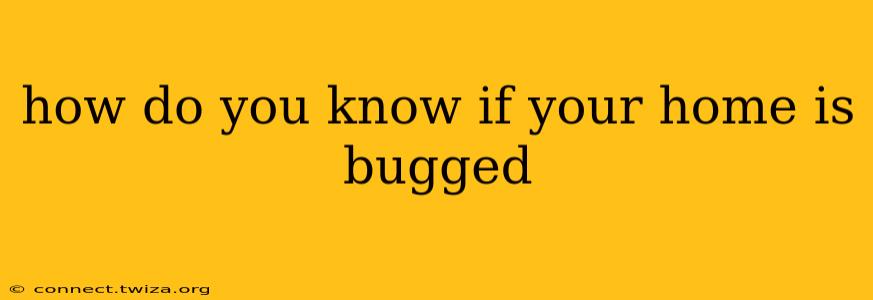How Do You Know If Your Home Is Bugged? A Comprehensive Guide to Detecting Hidden Surveillance
The unsettling thought of hidden surveillance devices in your home is a legitimate concern. Whether you suspect infidelity, corporate espionage, or simply feel a general unease, knowing how to detect potential bugs is crucial for protecting your privacy. This comprehensive guide will explore various methods and signs to help you determine if your home might be bugged.
What are the common signs of a bugged home?
This is a frequently asked question, and the answer is multifaceted. There isn't one single, definitive sign. Instead, it's often a combination of subtle clues that should raise suspicion. These clues might include unusual electronic sounds, unexplained activity on your devices, or even physical signs of tampering.
How can I detect hidden listening devices?
Discovering hidden microphones requires a multi-pronged approach. Start by visually inspecting your home. Look for anything out of place or unusually positioned – small objects that don't seem to belong, strangely placed electrical outlets, or anything that looks like it might contain a hidden camera or microphone. Pay close attention to common hiding spots, such as clocks, smoke detectors, lamps, picture frames, and even power adapters.
What about hidden cameras? Are there any telltale signs?
Hidden cameras often have tiny lenses that are easily missed. Look for small, pinhole-sized cameras, often disguised as everyday objects. Again, thoroughly inspect common hiding places. Some cameras might have tiny LEDs that illuminate when active. Use a flashlight at different angles to help detect them.
Are there any apps or devices that can help me detect bugs?
While no single app or device guarantees detection, several can assist. Many smartphone apps claim to detect RF signals from listening devices. Remember, however, that these apps can generate false positives due to the prevalence of various electronic signals in modern homes. Professional-grade bug detectors are available, utilizing more advanced technologies to identify surveillance equipment. These typically operate by detecting radio frequencies (RF) associated with hidden devices. While they are more reliable, they are also more expensive.
Can I use my smartphone to detect hidden cameras?
While a standard smartphone can’t directly detect hidden cameras like a professional bug sweep can, its camera can help. Use your phone's camera to scan for unusual reflections. A slightly brighter spot on a dark surface might indicate the lens of a hidden camera. This technique is most effective in low-light conditions.
What should I do if I suspect my home is bugged?
If you find evidence of a hidden device or have strong suspicions, don't try to remove it yourself. Contact law enforcement or a qualified security professional. They have the tools and expertise to safely and effectively remove any surveillance equipment while preserving potential evidence. Attempting to remove it yourself could damage evidence and potentially put you in harm's way.
How can I prevent my home from being bugged in the future?
Prevention is key. Regularly inspect your home for any suspicious devices or activity. Consider strengthening your home's security measures, including installing high-quality locks, security systems, and motion detectors. Be cautious about the information you share online and physically, minimizing potential targets for surveillance.
This guide provides a starting point for detecting hidden surveillance devices in your home. Remember that staying vigilant and utilizing a combination of methods will greatly increase your chances of identifying any potential threats to your privacy. Professional assistance is always recommended when facing a serious security concern.
